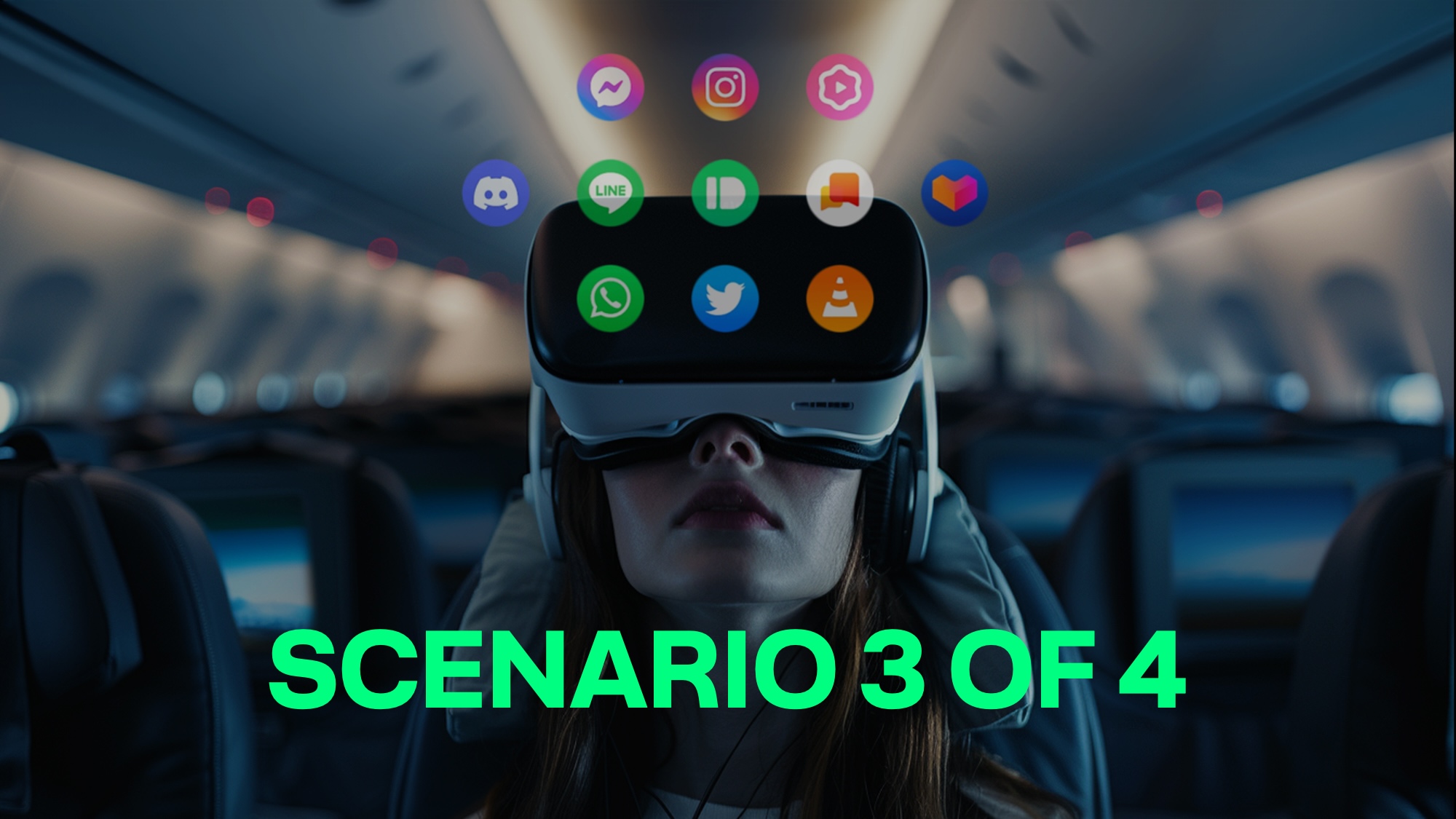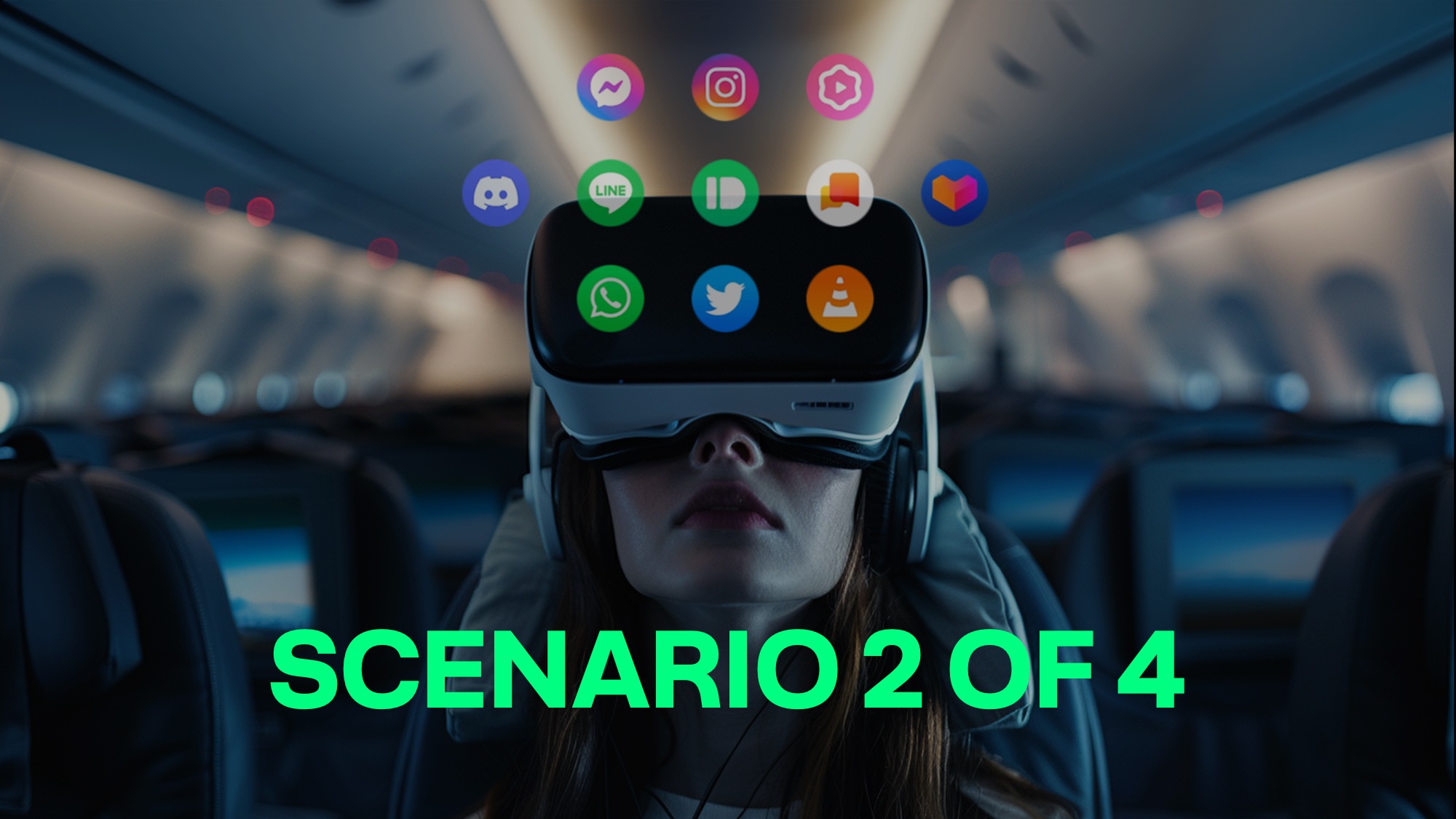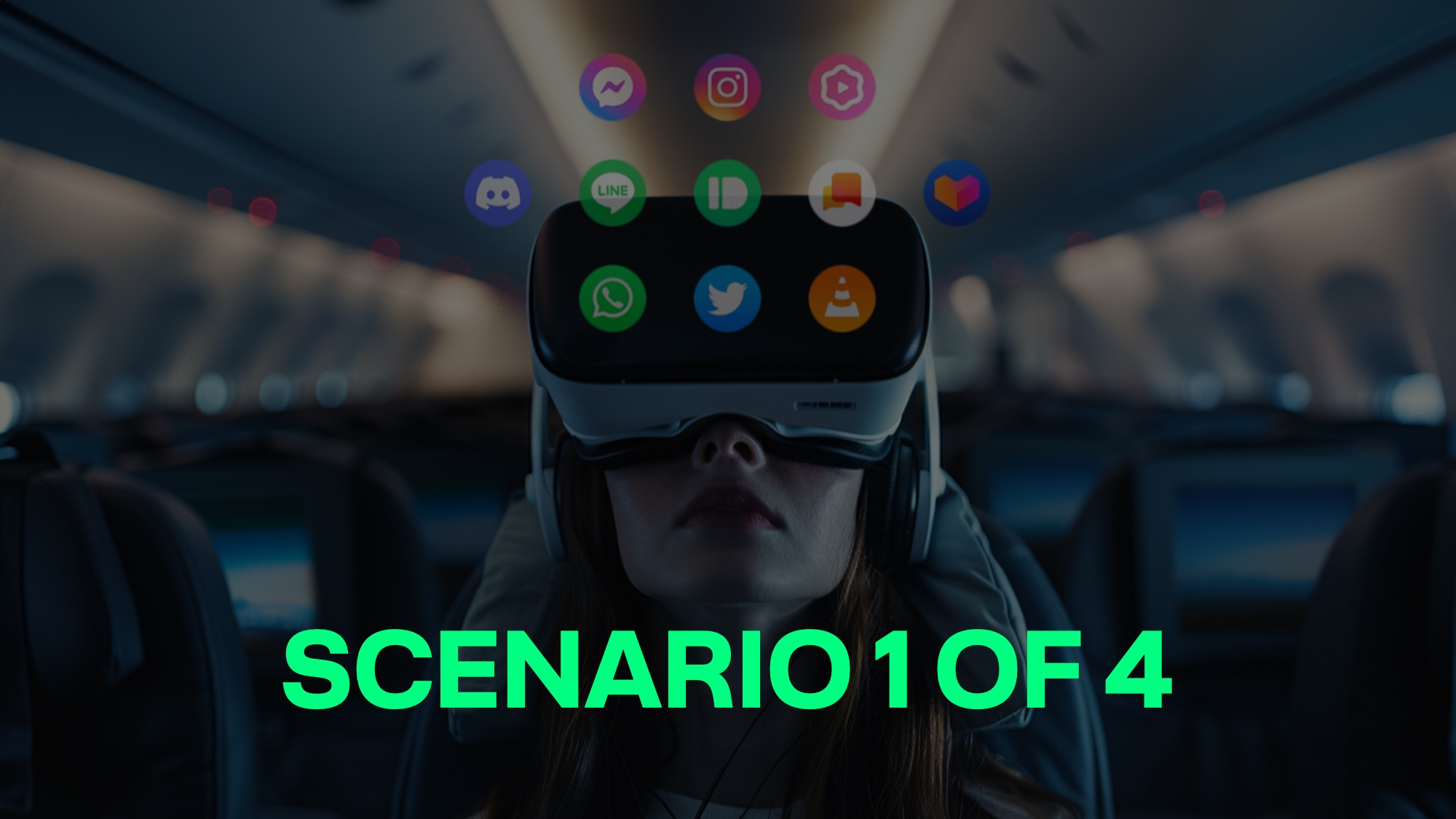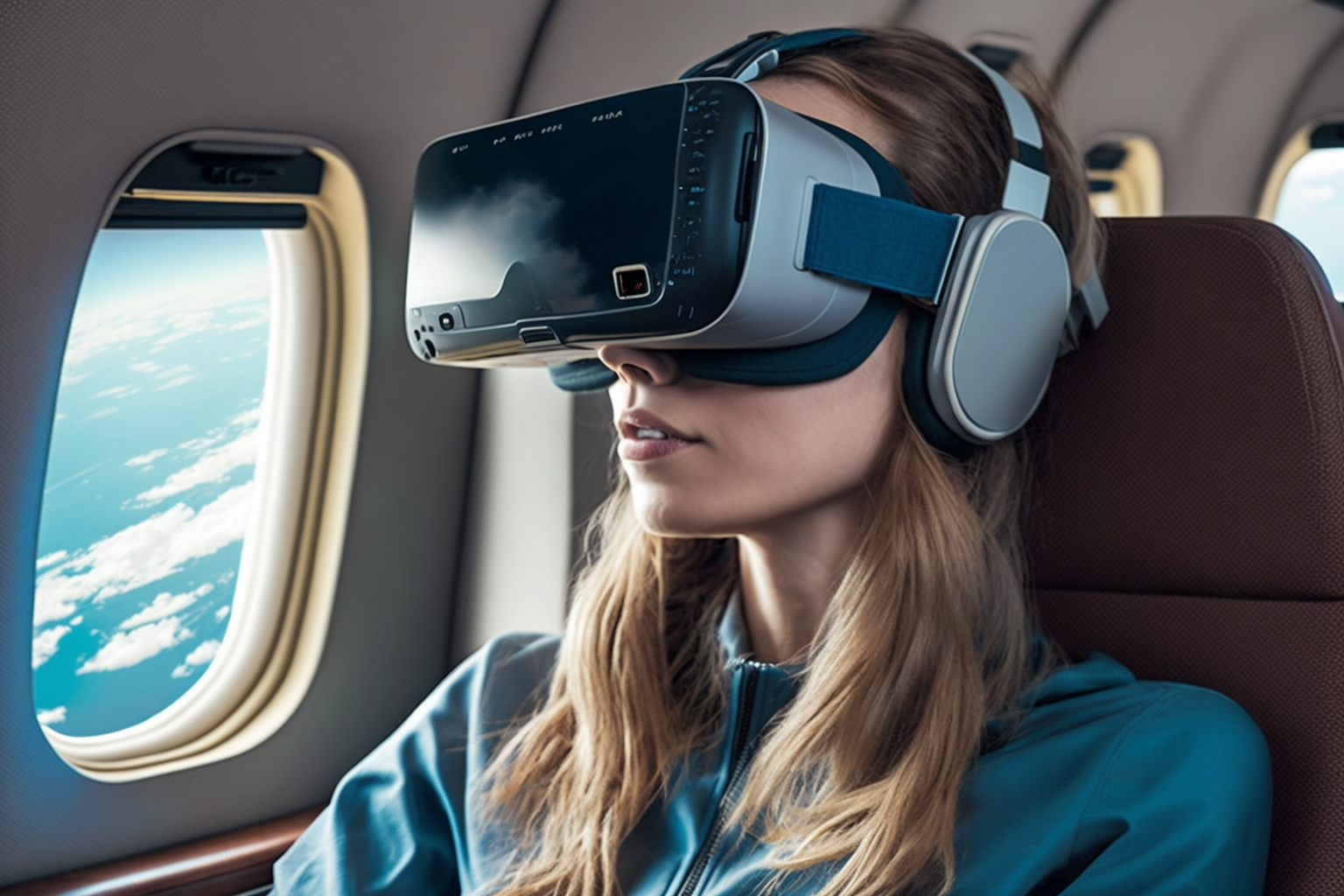This article marks the long-awaited conclusion of our five-part series exploring the metaverse’s transformative potential in the aviation industry.
Throughout this series—starting with the introduction that outlined our methodology—we have examined three distinct scenarios, each shaped by two critical factors: consumer adoption and metaverse consolidation. These factors are key to understanding the future of the metaverse in aviation, as both will have a significant impact on its development. Yet, their trajectory remains highly uncertain, making them central to any exploration of potential outcomes.
To recap:
- The Golden Islands imagined a future with limited consumer adoption due to high costs, where access to metaverse platforms would be fragmented, catering mainly to luxury and niche use cases in travel.
- The B2B2C Aviationverse envisioned a scenario where consumer adoption remained low, yet a unified metaverse infrastructure emerged, primarily benefiting industrial applications like training simulations and augmented operations.
- The Mainstream Multiverse considered widespread consumer adoption, transforming metaverse technologies into a mass commodity. However, the landscape remained fragmented, with diverse platforms catering to specific regions, demographics, and use cases.
Now, as the grand finale following deep dives into the three previous scenarios, we draw upon insights from industry leaders at Airbus, Bauhaus Luftfahrt, and our own experts at the Lufthansa Innovation Hub again to discuss the fourth and final scenario: The Bet is Won—the dawn of a fully immersive internet.

This scenario represents an ideal metaverse future for aviation, where both consumer adoption and integration are fully maximized. Although it borders on the utopian, it is not entirely out of reach.
- In The Bet is Won scenario, high consumer adoption of metaverse technologies is achieved through a range of accessible devices. Advanced headsets offer high-quality immersive experiences. Low-cost alternatives, such as desktop and mobile browsers, though less sophisticated, can support immersive visualizations and simulations and ensure that metaverse experiences are available to everyone, supporting a broad spectrum of use cases.
- This is complemented by low fragmentation, where an open standard connects all virtual environments into a cohesive “Metaverse Wide Web” (MWW). This interconnected web of virtual spaces would allow seamless transitions between different environments, creating a unified and immersive metaverse experience.
This ultimate vision of the metaverse would create a truly immersive and interconnected internet of spaces, transforming every aspect of the aviation industry—and beyond.
Let’s delve into what this ambitious metaverse might look like for both the B2C and B2B sides of the aviation industry.
In B2C: Realizing the Seamless Traveler Journey
“The Bet is Won” scenario is exciting because it envisions the realization of a long-held dream in the travel industry: creating a truly seamless traveler journey through advanced technology. Picture the consumer-facing side of aviation as a patchwork of applications and platforms integrated across the entire traveler journey—from travel inspiration to planning, accommodations, activities, and even post-trip experiences enhanced by extended reality and Web3.
While this vision may sound indeed utopian, it’s important to recognize that isolated metaverse applications already exist at various points along the traveler’s journey. What’s missing is a connected interface that seamlessly integrates these pilot projects and niche applications into one overarching virtual space. Currently, these use cases are fragmented—they are built using different standards and file types, are available on different platforms, and are accessible to distinct user groups.
Consider these examples of metaverse use cases already in play:
- Qatar Airways’ QVerse: In 2023, Qatar Airways expanded its QVerse platform with an AI-powered virtual assistant developed in collaboration with UneeQ, a US-based startup. This platform allows users to explore Qatar’s cabin classes virtually and interact with the virtual assistant for customer inquiries. This is part of a larger trend where travelers can increasingly explore destinations, cabins, accommodations, and experiences before booking through 3D virtual environments, enhancing their planning process and offering a realistic preview of the travel experience. Companies like Hotelverse, for example, are enabling hotels to create digital twins of their properties that support the booking process.
- Thailand’s Partnership with Freedom World: The Tourism Authority of Thailand has partnered with the Web3 loyalty app Freedom World, which offers travelers information on local events, interactive maps, gamified activities, and community-building features. The loyalty use case for metaverse technologies has also been explored by airlines such as Air Baltic, Emirates, Lufthansa, and brands like Rimowa, which have experimented with tokens and NFTs to create more engaging loyalty experiences.
- Immersive Customer Support: Virtual environments now offer real-time assistance through human-like avatars. These avatars typically utilize GenAI to provide automated natural-language assistance. However, this automation is supplemented by avatars that have facial expressions to give a “human touch” to the customer service experience. This concept is being trialed by Qatar Airways, airports like El Dorado and Dallas, and some hotels, potentially setting a new standard for customer service.
- Virtual Wayfinding: Metaverse technology is increasingly being used to help travelers navigate complex environments such as airports and cities. Bengaluru Airport in India, for instance, has released a digital twin to aid passenger navigation. Other airports are experimenting with parallel reality screens that can project personalized information to passengers on their way through the airport.
- Immersive In-Flight Entertainment: Metaverse technologies have begun allowing travelers to engage in immersive content, such as watching movies, playing games, or viewing products available for purchase. Lufthansa, for example, has piloted Meta’s Mixed Reality headsets for Business Class passengers on selected flights.
- Virtual Souvenirs: Travelers have started capturing and sharing digital memories of their journey, such as spatial imagery and interactive photos. Devices like the Apple Vision Pro have fueled platforms like the Amuz app that enable the sharing of spatial videos on 3D world maps.
In summary, the emergence of specific use cases along the entire traveler journey is already evident, and this trend is likely to intensify in the coming years.
- A recent survey by Phocuswright revealed that virtual reality is becoming a key tool for previewing travel destinations, accommodations, and experiences.
- According to the survey, between 35% and 45% of European travelers have used VR to preview destinations, hotels, or attractions, and nearly 30% have used it to preview airplane seats.

Given all these existing and hypothetical examples, we can expect many more metaverse applications to be launched across the traveler journey in the months and years to come.
However, these innovations will likely not reach their full commercial potential until they are organized under unified standards for creating and accessing metaverse applications—essentially, an “immersive web” that connects all these experiences and platforms into a cohesive virtual environment.
Imagine such an “immersive web” where all these fragmented metaverse experiences are seamlessly interconnected. Travelers could effortlessly transition between different stages of their journey—whether they’re exploring destinations, booking flights, checking into hotels, or navigating airports—without ever leaving a unified virtual environment that could even run continuously on their VR devices. This interconnected web of experiences would function as a digital twin of the travel journey, seamlessly connecting experiences across all areas of the trip.
- For example, a traveler could start their trip by using a virtual assistant to explore flight options in an immersive cabin environment, then seamlessly transition to a 3D hotel tour where they can select their preferred room and amenities.
- Upon arrival at their destination, virtual wayfinding tools could guide them through the airport up until their accommodation, while immersive customer support avatars are available to assist with hotel check-in and any questions or issues.
Such an interconnected metaverse wouldn’t just enhance the traveler experience—it could revolutionize how we think about travel, blending the physical and digital worlds into a truly seamless, technology-assisted journey.
In B2B: The Wonder Workbench Maximizes Collaboration in Aviation
Applying “The Bet is Won” imagination to the B2B side of the aviation industry unveils an equally fascinating and promising future. In this fully “metaversed” world, we can envision the emergence of a shared, interoperable platform—a “Metaverse Aviation Workbench”—that revolutionizes how airlines, manufacturers, and other industry stakeholders collaborate on design, engineering, and maintenance activities.
This imagined platform would serve as a central hub, seamlessly integrating cutting-edge technologies such as digital twins, IoT, and blockchain into one comprehensive industry-wide workbench. The result would be an unprecedented level of collaboration, where real-time data and virtual simulations drive faster, more efficient decision-making across the aviation value chain.
- For instance, digital twins—virtual replicas of physical assets—could allow manufacturers to simulate and optimize aircraft designs before they ever take flight, reducing development time and costs.
- IoT devices could continuously feed real-time performance data into the metaverse, enabling predictive maintenance and minimizing downtime.
- These technologies offer potential for advanced engineering techniques like zero prototyping that can be used to build virtual models of prototypes and test them using virtual simulations.
- Meanwhile, blockchain could ensure secure, transparent transactions and record-keeping, streamlining the entire supply chain from parts procurement to final assembly.
At the same time, given that the metaverse would be highly adopted on the consumer side, people would transfer the benefits of virtual environments for personal productivity to their professional productivity as well.
We would see the development of enterprise productivity solutions, like virtual meeting spaces using sophisticated avatars that replicate gestures and facial expressions, virtual training embedded across organizational functions, and virtually enabled collaboration in 3D design spaces and workflow replicas that support situational awareness in digital and virtual environments.
While this all sounds like an impossible dream scenario, the building blocks of this ultimate metaverse future are indeed being laid, with isolated applications gradually taking hold.
For example:
- US-based startup HeyGen, known for creating an AI-enabled video creation app for social media, made headlines when it launched a new product that allows users to create custom AI avatars that can appear in videos in just five minutes. Following this product launch, the company recently announced it had raised an astounding $60 million USD in a funding round that valued the company at $500 million USD, testifying to the bullish sentiment investors place on this future. This type of technology can revolutionize online conferencing, making lifelike avatars a mass commodity.
- Major OEMs like Airbus, Boeing, and Rolls Royce have already integrated digital twins into their engineering workflows. These digital replicas are enhancing the design and engineering processes by allowing multiple stakeholders to collaborate in virtual environments. This enables them to refine designs without the need for physical prototypes, significantly reducing costs and accelerating time-to-market. Although augmented maintenance using digital twins is still largely experimental, it represents a promising frontier for further innovation.
- Companies like Lotte Duty Free and 3D Seatmaps VR are developing highly relevant virtual content for the aviation industry, such as virtual store experiences and 3D seat maps. However, the industry has been slow to merge these efforts and create a shared content platform across organizations. In the future, this could evolve into the co-creation of content within virtual spaces, such as in-flight entertainment (IFE) and virtual customer experiences, which can be deployed across various digital platforms to enhance passenger engagement.
- Heathrow Airport is experimenting with blockchain technology to improve cargo handling workflows and using digital twins to better understand passenger movements through the airport. These initiatives are early steps toward leveraging virtual tools to streamline processes like supply chain management, maintenance, and real-time operational monitoring, which could have a significant impact on the efficiency and effectiveness of aviation operations in the future.
In all fairness, while these use cases demonstrate significant progress, they currently operate on fragmented infrastructures. What’s missing is a unified, shared infrastructure that could connect these isolated efforts into a cohesive, interoperable system—the very essence of the “Wonder Workbench.”
In this fully interconnected environment, the traditional silos that often slow down progress in the aviation industry would dissolve, fostering a new era of innovation and operational efficiency.
The “Wonder Workbench” would not only enhance collaboration among stakeholders but also pave the way for more sustainable, resilient, and agile aviation operations in the future.
And, in fact, the first projects aiming to establish better collaboration across the aviation value chain in “shared metaverse spaces” are already being built:
- One great example is NVIDIA’s Omniverse. It was launched in 2020 and supports collaborative creation of 3D computer graphics and simulations across various fields, such as game design, architecture, and engineering. This platform is also used in aerospace. For instance, in 2022, aerospace supplier Lockheed Martin launched a collaboration on Omniverse to build an AI-powered “Earth Observations” Digital Twin to monitor weather events and environmental conditions across the globe.
- Launched in September 2022, the GENEX project is spearheaded by a consortium of 16 leading aerospace companies and research institutions across Europe. This project aims to use digital twin processes to manage the entire life cycle of aircraft composite structures, provide better insight into component manufacturing, history, and repairs, and improve sustainability practices in the aftermarket.
In May this year, the UK’s “Digital Catapult”—a governmental authority advancing digital technology in the UK—announced the launch of the UK Digital Twin Centre. This organization, based in Belfast, aims to accelerate the use of digital twins across industries, with a particular focus on aerospace. Backed by funding from aerospace and defense firm Thales UK and aerostructure company Spirit Aerosystems, the Digital Twin Centre aims to demonstrate the potential of digital twins in maritime, aerospace, and defense.

By bringing all these use cases together under a common framework, the aviation industry could unlock the full potential of digital innovation, transforming not just how it operates but how it innovates, collaborates, and evolves in the metaverse era. After all, the metaverse blurs the lines between physical and virtual realities by leveraging immersive technologies and enabling the ownership and exchange of virtual assets through blockchain and Web3.
Conclusion: Navigating the Metaverse Future of Aviation
The Bet is Won scenario imagines a future where immersive technology, metaverse platforms, and applications seamlessly integrate into every aspect of our lives.
Picture this world:
- You wake up, put on your smart glasses, and your entire day is infused with metaverse experiences.
- As you make your morning coffee, you’re virtually browsing your calendar and checking the news, all blended into your physical surroundings.
- During your train ride to work, you seamlessly book your next business trip without needing a handheld device—using your voice or simple gestures, you can search for hotels and flights.
- With a Web3-based wallet, you securely input your booking details with a single click.
- You also use virtual previews to assess your hotel options, making sure the room is spacious enough for work and doesn’t have inconvenient layouts, like a bedside table that you might bump into every morning.
- Next, you access a virtual map of your destination, planning to extend your trip with a weekend getaway. This immersive map allows you to explore potential destinations, preview hiking trails, and get a real sense of the area’s attractions.
- Upon arriving at work, you join a virtual meeting where your avatar interacts naturally with holograms of your colleagues in China, making the meeting feel more immersive and connected.
- Despite being in a physical room, their presence is fully integrated into your environment. Your Chinese counterparts pull up a real-time digital twin of their local aircraft maintenance facility, walking you through procedural updates in the hangar. You can directly compare the old workflow to the new one using virtual models, visualizing the improvements in real-time.
- Through the “Aviationverse,” you annotate the model with your suggestions, all of which are saved and timestamped on a blockchain for transparency and accessibility to every stakeholder in the space.
While this vision of the metaverse may sound like an ultra-bullish, idealized future, it’s not entirely out of reach. Avatars, digital twins, and virtual prototyping are gaining momentum among startups and industry giants alike. In fact, digital twins are becoming central to aircraft manufacturing, and virtual destination previews are already gaining traction with tech-savvy travelers.
Moreover, this metaverse-driven future will usher in unprecedented levels of productivity and efficiency across the entire aviation value chain—from manufacturing and operations to customer service.
With these thoughts on the ultimate metaverse future in aviation, let’s take a step back and reflect on what we’ve learned through the exploration of these four scenarios.
We’ve explored multiple possible futures for aviation in the metaverse. While each scenario represents a potential pathway, the key question remains: what’s truly likely to unfold?
And what do these scenarios ultimately tell us about the future of aviation?
We want to highlight four key insights to wrap up our scenario work.
Key Insight #1: Early Indicators Across All Scenarios
There are clear early indicators, use cases, and industry events that support each of the metaverse scenarios we’ve outlined. Therefore, no scenario should be considered impossible.
- The Golden Islands: We’ve shown that NFTs and immersive experiences are becoming integral to luxury travel, particularly in the retail and fashion context. Devices like the Varjo XR and Apple Vision Pro, priced at $3,000+ USD, cater to the luxury traveler segment, reinforcing this scenario.
- The B2B Aviationverse: Industry leaders like Airbus and Rolls Royce are already utilizing digital twins for engineering and industrial design, while VR and simulations have become the norm in aviation training, including for engineering, MRO, cabin crew, and pilots. This proves that specific B2B metaverse workbenches are being built.
- The Mainstream Multiverse: Various players in the travel industry are leveraging extended reality to enhance travel inspiration and using Web3-based loyalty tokens to engage a new generation of travelers. Mass adoption of metaverse technologies in aviation is not out of sight.
- The Bet is Won: We’re seeing early signs of major industry stakeholders creating unified metaverse spaces, suggesting a move towards more integrated virtual environments, potentially forming the metaverse internet of the future.
All these examples demonstrate that each scenario has a credible foundation, making them worthy of consideration as potential future pathways for the metaverse in aviation.
But which scenario is most likely to become reality? This brings us to the next key insight.
Key Insight #2: A Patchwork Future
The future of the metaverse is unlikely to be black or white. Instead, it will likely be a patchwork of elements from each of these scenarios, depending on specific use cases and context. We may also see an evolution where one scenario transitions into another, for instance, as consumer adoption accelerates or new technology standards emerge to unify platform development. Therefore, travel providers should apply these scenarios to their unique situations:
- The Golden Islands use cases may be particularly relevant if you’re focused on the premium travel market.
- If your goal is to improve operational workflows using various forms of virtual reality, the B2B2C Aviationverse offers valuable insights.
- If you’re interested in enhancing traveler experiences with extended reality and Web3, especially in the mass traveler context, consider the Mainstream Multiverse and The Bet is Won scenarios.
Each scenario provides a lens through which travel providers can explore how metaverse technologies might evolve and influence their business strategies.
In summary, context matters, and the metaverse future is going to be nuanced. But there is one thing all metaverse scenarios have in common.
Key Insight #3: Efficiency Gains Across the Board
Regardless of the scenario, one common theme is the potential for metaverse technologies to make various workflows and procedures in aviation more efficient. This applies to both B2C and B2B contexts:
- For consumers, virtual previews can simplify travel planning by catering to individual preferences, just to name one example.
- On the B2B side, the efficiency gains from digital twins and virtual training are substantial, directly impacting cost and scalability.
The metaverse is not about substituting physical travel with virtual experiences.
Instead, it’s about enhancing the physical travel experience by making it more seamless and efficient through technology.
This drive toward efficiency is not going to slow down anytime soon.
Key Insight #4: Rapid Expansion Despite Hype Slowdown
Our analysis also reveals that, despite the slowdown in mainstream metaverse hype, technological experimentation in the aviation industry is rapidly expanding. Numerous players across the aviation value chain continue to explore Web3 and extended reality applications.
Whether elements of the “Golden Islands,” “B2B2C Aviationverse,” or “Mainstream Multiverse” scenarios materialize, highly relevant use cases are emerging for aviation stakeholders.
These include enhancing customer experiences with virtual previews, improving operational efficiency with digital twins, and creating more engaging loyalty programs through Web3 technologies.
Final Thoughts: Stay Informed!
The metaverse is poised to redefine the future of aviation, and staying informed will be key to navigating this transformation successfully. Each scenario highlights different opportunities, but all emphasize the transformative potential of metaverse technologies within aviation.
Monitoring these developments will be crucial for strategic decision-making. It’s mission-critical for travel providers and brands to keep a close eye on these advancements to avoid missing out on emerging opportunities.
We are committed to continuing our monitoring of the space and urge you to do the same.










